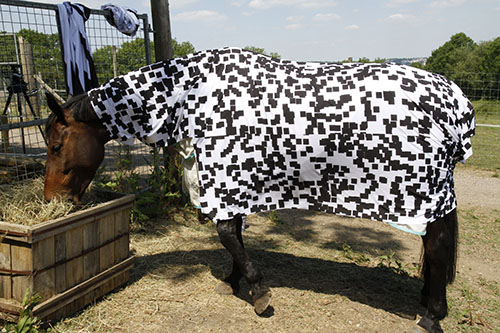Zebras are some of the most fascinating animals in the world. From kindergarten kids to biologists, the zebras’ dazzling black-and-white display has been a constant source of puzzlement and curiosity. Zebras are black with white stripes, if you were wondering, but why do they have white stripes in the first place?
In a new study, researchers dressed horses in all sorts of black-and-white coats and found that coats that look like zebras’ coats do an excellent job at keeping horseflies away.

Since at least the 19th century, researchers have wondered why zebras have stripes — and there are probably more hypotheses than you think. For starters, there’s the confusion hypothesis, which states that zebra stripes confuse predators, making it harder to distinguish between different individuals in a group and makes zebras less noticeable. Then, there’s the thermoregulatory hypothesis, which suggests that stripes help to control a zebra’s body temperature. Studies have also suggested that stripes serve as warning coloration or that they serve a social role, like an individual fingerprint.
But in recent years, one particular idea is picking up traction.
The idea is a variation of the confusion theory, and it basically says that zebra stripes serve as a deterrent, but not for predators — for insects, and specifically horseflies.
Horseflies have been around since the age of the dinosaurs, and their bite can be nasty. Granted, horses and zebras have thicker skin than humans, but even for them, horseflies can be a problem. It’s also quite difficult for them to get rid of flies: you or I could whack the flies or flail our arms and try to scare them away, but for hoofed animals, that’s hardly an option.

Turns out, horseflies don’t like stripes. It’s not clear why, but they simply don’t like landing on stripes. But they only seem to hate some types of stripes. Tim Caro and Martin How, both from the University of Bristol’s School of Biological Sciences, set out to investigate this.
“We knew that horseflies are averse to landing on striped objects – a number of studies have now shown this, but it is not clear which aspects of stripes they find aversive,” Caro says.
“Is it the thinness of the stripes? The contrast of black and white? The polarized signal that can be given off objects? So we set out to explore these issues using different patterned cloths draped over horses and filmed incoming horseflies.”
Because the researchers couldn’t take zebras and swap their stripes around, they did the next best thing: they wrapped horses in different striped sheets and measured what effect this has on horseflies.
They found that large, dark objects attract the flies, and grey coats attract them even more. Coats with large black triangles and small checkerboard particles also didn’t seem to deter the flies. What did deter the horseflies were patterns of sharply contrasting stripes.
“We found that horseflies are averse to landing on highly (but not on lightly) contrasting stripes printed on horse coats. We could find no evidence for horseflies being attracted to coats that better reflected polarized light. Horseflies were somewhat less attracted to regular than to irregular check patterns,” the researchers note in the study.
Based on the results, they double down on the idea that the zebras’ stripes work as an anti-parasite mechanism.
But this doesn’t answer one key question: if this type of stripe offers such a significant evolutionary advantage, why haven’t other related species developed anything like it? Caro says
“We know that zebra pelage – fur – is short, enabling horsefly mouthparts to reach the skin and blood capillaries below, which may make them particularly susceptible to fly annoyance, but more important, perhaps, is that the diseases that they carry are fatal to the horse family but less so to ungulates. This needs investigation.”
The study was published in the Journal of Experimental Biology.









